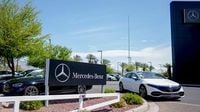The price of a new car in the United States has officially crossed a psychological—and financial—milestone. According to recent data from Kelley Blue Book, the average transaction price (ATP) for a new vehicle in September 2025 soared past the $50,000 mark for the first time in history, settling at $50,080. This figure represents a 2.1% jump from August and a 3.6% increase compared to the same month last year, marking the largest annual gain since the spring of 2023 (as reported by Fox Business and Kelley Blue Book).
But what’s fueling this relentless climb in car prices? The answer, it seems, is a complex mix of market forces, shifting consumer preferences, and economic policy. As 2026 model-year vehicles began appearing on dealer lots in September, the average manufacturer’s suggested retail price (MSRP)—the so-called "asking price"—also hit a record high of $52,183, up 4.2% year over year, according to Kelley Blue Book’s latest report. That’s not just a number on a sticker; for many Americans, it’s a barrier to entry that’s getting higher every year.
One of the standout trends in this market is the growing share of luxury vehicles. More than 60 models now have average selling prices above $75,000, and nearly 94,000 of these high-end vehicles were sold in September alone. That’s 7.4% of all new vehicles sold—up from 6% a year earlier, as highlighted by Fox Business and Car and Driver. Among six-figure vehicles, the Cadillac Escalade was the most in-demand, with 4,320 units sold in September. Porsche, meanwhile, topped the chart for average transaction price at a staggering $119,853, while Mitsubishi, at the other end, posted the lowest ATP at $34,356—though even that represented a 34.4% increase year over year.
What’s behind the luxury surge? Brian Moody, executive editor at Autotrader, points to a convergence of factors: "We’ve been heading for this intersection for quite some time—the price of electric cars, tariffs, government-mandated equipment, increasing popularity of hybrids, the continuing popularity of trucks, and full-size electric trucks, are all contributing to the higher average transaction price."
Electric vehicles (EVs) are playing a starring role in this drama. In September, EVs accounted for 11.6% of the new vehicle market, an all-time high, according to Kelley Blue Book. The average price for a new EV last month was $58,124, up 3.5% from August. EV sales are not just growing—they’re breaking records. The third quarter of 2025 saw 437,487 electric vehicles sold, a new high, with many buyers racing to take advantage of a $7,500 federal tax credit that expired at the end of September. As Car and Driver reported, this rush contributed to the price spike, as buyers sought to lock in incentives before they vanished.
Incentive spending itself reached new heights, too. Automakers and dealers offered discounts and promotions that averaged $3,700 per new vehicle in September—7.4% of the average transaction price and the highest level seen in 2025. Yet, these incentives haven’t been enough to offset the upward pressure on prices. As Erin Keating, executive analyst at Cox Automotive (parent company of Kelley Blue Book), put it: "Prices go up over time, and today’s market is certainly reminding us of that. The $20,000 vehicle is now mostly extinct, and many price-conscious buyers are sidelined or cruising in the used-vehicle market."
Keating adds that the market is increasingly being driven by wealthier households: "Today’s auto market is being driven by wealthier households who have access to capital, good loan rates, and are propping up the higher end of the market." It’s a sobering reality for many Americans who find themselves priced out of the new car market. While there are still some affordable options out there, many buyers are either waiting on the sidelines or turning to used vehicles, as noted by both Fox Business and Kelley Blue Book.
Another major force behind the price spike? Tariffs. The White House’s long-term trade deals have locked in hefty tariffs on imported vehicles and parts. For a while, automakers absorbed these costs, hoping for relief through trade negotiations. But as those hopes faded, manufacturers began passing the costs on to consumers. According to Car and Driver, "Tariffs have introduced new cost pressure to the business, but the pricing story in September was mostly driven by the healthy mix of EVs and higher-end vehicles pushing the new-vehicle ATP into uncharted territory."
It’s not just tariffs and incentives at play. The arrival of 2026 model-year vehicles pushed average MSRPs even higher. New model years typically bring price increases, but this year’s jump is especially pronounced. And while some automakers are beginning to introduce lower-priced EVs—Tesla and Hyundai have both announced such moves—these are exceptions rather than the rule. The overall market trend is still firmly upward.
It’s worth noting that the best-selling vehicle in America remains a Ford pickup truck, which now routinely costs more than $65,000. That’s emblematic of a broader shift: Americans are not just buying more expensive vehicles—they’re choosing them. The popularity of full-size trucks, SUVs, and luxury models is pushing the average price higher, even as some automakers try to offer budget-friendly alternatives.
Some might wonder if relief is on the horizon. The answer, for now, appears to be: not much. While a few brands are experimenting with price cuts—Tesla’s new lower-priced models and Hyundai’s reduction on the Ioniq 5 are notable examples—the broader market is still being shaped by strong demand for high-end vehicles, the lingering effects of tariffs, and a rush to capitalize on government incentives before they disappear.
For buyers, the message is clear: the days of the $20,000 new car are all but over. As Moody put it, "We’ve been heading for this intersection for quite some time." Whether you’re in the market for a luxury SUV, an electric sedan, or a trusty pickup, expect to pay more than ever before. And with economic forces showing little sign of reversing course, higher prices may be here to stay—at least for the foreseeable future.
In a market defined by record highs and shifting dynamics, American car buyers face tough choices. Some are rushing to buy before incentives expire, others are turning to used vehicles, and many are simply waiting for a break that may not come. For now, the new car market is a place where wealth, policy, and preference intersect—often at a price that leaves many on the outside looking in.



